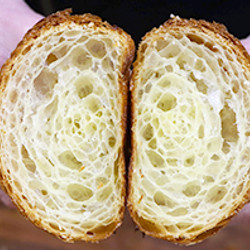Croissants can only be made perfectly if the temperature is correct, start by chilling your dough hook and bowl before preparations begin.
Pour milk into your mixing bowl and add flour, sugar and butter.
Next add the yeast and salt keeping them separate in the bowl.
Start mixing the croissant dough using a dough hook and making sure the temperature of the ingredients does not go above 23°C/73.4°F.
Use a slow setting to start off with so the ingredients can combine well and once everything has incorporated well, increase the speed.
Mixing the croissant dough should take no longer than 15 minutes.
If you’re unsure, check the temperature of the dough – it should be no higher than 23°C.
Put the croissant dough onto your bench and start to knead it gently for a short time to help create the gluten and a smooth surface, creating a large ball.
Cover the croissant dough ball using plastic wrap and leave it to rest for 20-30 minutes.
After 30 min, the dough should be slightly puffy but not gassy – if the room temperature it is too warm the dough will not turn out well.
Use a rolling pin, with movements back and forth, to commence flattening the dough and using strokes so that you create a rectangle shape.
Cover a 60’x40’ tray with plastic wrap tightly and place croissant dough on top, continuing to smooth it out with a rolling pin.
To get the corners into the right shape, roll diagonally from the centre of the dough to each corner, making sure it is even all around.
Gently pull it on all sides, making sure it takes up the whole size of the tray.
Cover the dough (leaving it on the tray), with plastic wrap, flattening it down around the sides of the croissant dough so there are no air bubbles.
Freeze the dough for 1-2hr, then put it in the fridge overnight/for at least 12hr.
To prepare the buttersheet, pass it first through a pastry sheeter.
Before sheeting your dough, put it in the freezer for another 30 minutes (or less if you’re using standard commercial butter).
Once the dough reaches approx. 1°C/33.8°F, you can remove it from the freezer. It should be pliable and elastic but not too soft.
Next pass the croissant dough through the sheeter until it stretches out.
Place the buttersheet on top of the dough (to one side) and it should take up half of it, otherwise you will need to remove some of the pastry or stretch it out further.
Fold over the side closest to you (if there is any trimming left) and press down gently on it.
Cut the other half of the dough off using a sharp knife and place it on top, making sure it is even all the way around and press down slightly.
There should be 2 layers of dough and one of butter in the middle
Next it’s time to go through the lamination process. The sheet must be thinned down to 10mm/.39inch thickness.
Once the sheet has stretched out, cut it into 3 equal parts using a sharp knife and layer them on top of one another.
Take this through the pastry sheeter once again, making it longer and thinner once again then trim off the uneven ends.
Create the 3 layers once again by cutting the pastry into 3 equal parts, making sure you create a clean, smooth block and the layers are perfectly aligned.
Cover this with baking paper smoothing it over the top and wrapping it up before leaving it in the fridge for up to 30 minutes.
Repeat the sheeting, cutting and layering one final time and ensure the pastry is 10mm thickness. This will give you 37 layers.
Wrap the dough tightly in plastic and this can then be either be frozen for up to 1 week, or if making same day, put in the fridge then when ready to roll out, freeze for 30 minutes before you start..
Run the croissant pastry back and forth through the sheeter until you reach a thickness of 5mm/0.19inch.
Next, even it out using a rolling pin. Roll the dough up and back through.
Now measure up to 9cm width and cut on a diagonal, creating a long triangle shape. Starting at the bottom, measure 9cm again, and cut upwards so the next triangle will have the point at the top.
Each portion should weigh 90-97g and can be placed on a tray pre-lined with baking paper or covered in plastic wrap.
Leave the croissant portions to rest for 15 minutes on the tray and cover with baking paper.
To shape, take one portion, stretch it out gently holding the longer part in one hand and pulling at the bottom.
Starting from the wider end, begin to roll the pastry down using fingers from both hands until you reach the point.
Set proofer to 28°C/82.4°F / 85% humidity and leave to proof for 2-2.5hr.
Using a fine painters brush, brush egg wash over the top of the horizontal layers only.
Cook on the conventional oven setting at 170°C/338°F (100% humidity) for 10 minutes, then drop the temperature to 160°C for another 10-11minutes.
E ora si mangia, Vincenzo’s Plate….Enjoy!
